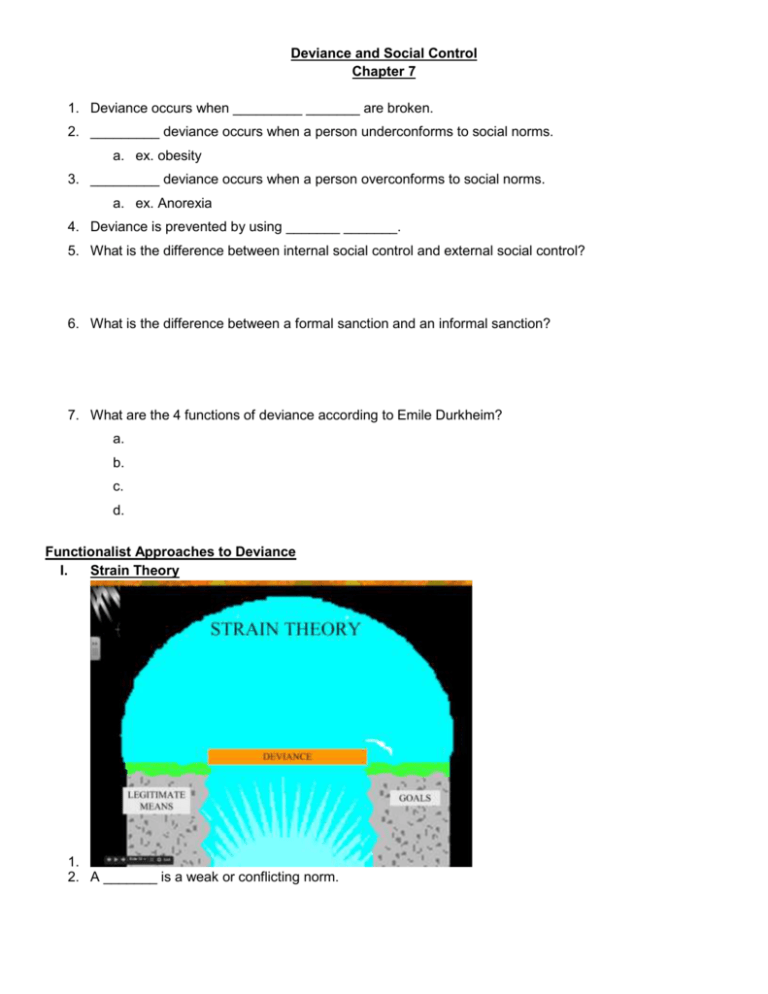File
advertisement

Deviance and Social Control Chapter 7 1. Deviance occurs when _________ _______ are broken. 2. _________ deviance occurs when a person underconforms to social norms. a. ex. obesity 3. _________ deviance occurs when a person overconforms to social norms. a. ex. Anorexia 4. Deviance is prevented by using _______ _______. 5. What is the difference between internal social control and external social control? 6. What is the difference between a formal sanction and an informal sanction? 7. What are the 4 functions of deviance according to Emile Durkheim? a. b. c. d. Functionalist Approaches to Deviance I. Strain Theory 1. 2. A _______ is a weak or conflicting norm. 3. The strain theory states that there is a _______ between _________ goals (norms) and a ____________ way of attaining them. a. Example:__________________________________ 4. There are four ways to respond to social strain: a. Innovation: i. Example: b. Ritualism: i. Example: c. Retreatism: i. Example: d. Rebellion: i. Example: 5. REFLECT: According to the strain theory, why do people become deviant? Is it always negative? II. Control Theory 1. The control theory states that more ________ you have with individuals and society, the ______ likely you are to become deviant. 2. Social bonds help individuals reach _________ appropriate goals. 3. What are the four basic elements of a social bond? a. b. c. d. 4. REFLECTION: According to the Control Theory, why do people become deviant? What social bonds do you have in your life that encourages you to stick to social norms? Symbolic Interactionist Approaches to Deviance III. Differential Association Theory 1. The differential association theory states that an individual with exposure to a higher _______ of deviant people at a younger ________ is more likely to become deviant. The opposite is also true. Individuals with exposures to a lower _________ of deviant behaviors at a younger _______ is less likely to become deviant. 2. REFLECTION: What firsthand experience do you have with Differential Association? Do you agree with the theory? Does it have any flaws? In other words, can individuals overcome what they have seen or become deviant later in life even though they have had a positive upbringing? IV. Labeling Theory 1. The labeling theory states that ________ determines what is _______ and _______ individuals according to the norm. 2. A flaw with the labeling theory is that two people can commit the same ________ act and may not be ________ the same. We _________ some people to be deviant. 3. Two types of deviance: a. primary deviance = b. secondary deviance = 4. What are the consequences of labeling individuals? a. b. c. Reflect: In each of the cases below… d. Identify a label, which may be attached to the person as a result of their deviant behavior. e. Outline how a deviant career may develop by describing the possible consequences of the labeling for the person’s future life and relationships. f. Suggest ways in which that person might avoid being labeled even after they have committed the deviant act. 1. A young woman who is caught shoplifting in Wal-Mart. 2. A person who is temporarily admitted to a mental hospital as a result of a nervous breakdown. 3. An 18-year-old man who gets arrested during a fight at a football game. REFLECT: Can labeling increase secondary deviance? Explain your answer. Conflict Theory Approaches to Deviance 1. According to conflict theory ________ is seen as threatening to those in _________. 2. What are the reasons for this difference? a. Low income/Poverty b. Victim Discounting 3. What is white-collar crime? 4. How are the consequences different from other types of crime? REFLECT: What do you see in your everyday life that relates to these concepts? Approaches to Crime Control 1. Deterrence = a. Does the death penalty actually deter people from committing crimes? 2. Retribution =. 3. Incarceration = 4. Rehabilitation = a. What are some alternatives to prisons? 5. Define recidivism. REFLECT: Do you think the current approaches are working? Explain your answer.




